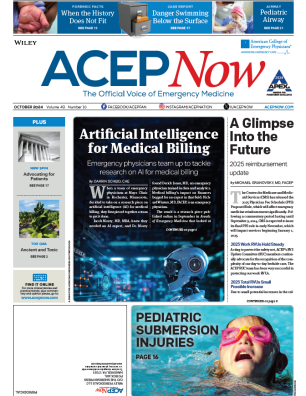
Case
A critically ill patient presents to the emergency department (ED) requiring an emergent, definitive airway. While preparing to perform the endotracheal intubation with video laryngoscopy, you remember a randomized controlled trial (RCT) recently suggesting etomidate could increase mortality if used as the induction agent.
Explore This Issue
ACEP Now: Vol 42 – No 08 – August 2023Background
Etomidate has been a popular induction agent for critically ill patients for more than a decade. This is due to its being hemodynamically neutral and its fast onset of action. However, a 2012 systematic review and meta-analysis (SRMA) reported that etomidate was associated with adrenal insufficiency and increased mortality in septic patients.1
There have been multiple randomized trials studying the effect of etomidate as an induction agent on adrenal function and mortality. These studies have reported mixed results—with some finding a statistically significant increase in mortality. A recent, single-center, randomized trial compared etomidate versus ketamine in adult patients requiring emergency endotracheal intubation.2 The primary outcome was all-cause mortality at seven days and showed an eight percent absolute increase for patients allocated to the etomidate group. This outcome was no longer statistically different at 28 days. There were multiple issues with this trial including a lack of masking and potential selection bias.
A new SRMA was published in 2021 that reported an associated increase in adrenal suppression and mortality with etomidate. However, this review combined high-level studies (five randomized controlled trials) with low-level studies (nine post hoc and 15 retrospective studies).3
Clinical Question
Will using etomidate as an induction agent in critically ill adult patients cause an increase in mortality?
Reference: Kotani, et al. Etomidate as an induction agent for endotracheal intubation in critically ill patients: A meta-analysis of randomized trials. J Crit Care. 2023;77:154317.
Population: Critically ill adult patients requiring emergency endotracheal intubation
- Exclusions: Pediatric patients less than or equal to 15 years old, etomidate as an infusion, non-randomized trials, systematic reviews, commentaries or editorials, literature reviews, studies not addressing the review question
- Intervention: Etomidate
- Comparison: Any other induction agent
- Outcomes:
- Primary Outcome: Mortality at the main time point defined by trial authors
- Secondary Outcome: Adrenal insufficiency
Authors’ Conclusions
“This meta-analysis found a high probability that etomidate increases mortality when used as an induction agent in critically ill patients with a number needed to harm [NNH] of 31.”
Results
Eleven randomized trials were included in this study (n=2,704 patients). Etomidate was compared in four studies to ketamine, in four studies to midazolam, in one study to thiopental, in one study to ketamine with midazolam, and in one study to ketamine with propofol.
Pages: 1 2 3 | Single Page



No Responses to “Should You Etomidate Me?”